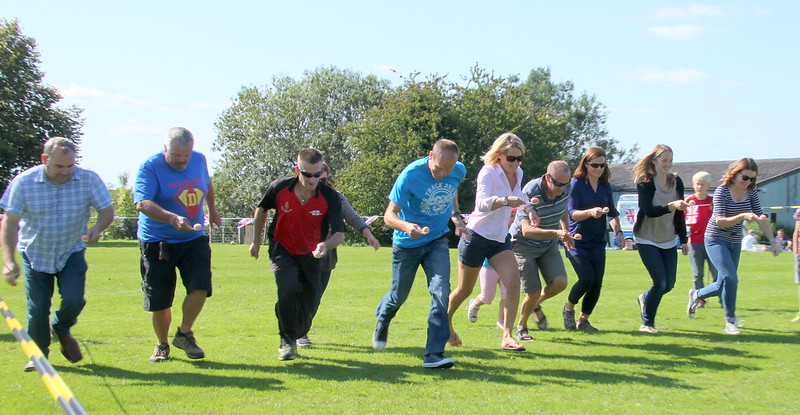The egg and spoon Race originated in English fairs in the late 19th century. It symbolizes community and balance skills and is played globally.
The game requires a spoon and an egg, and it can include obstacles, relays, or themed races. Benefits include increased physical activity, teamwork, and balance improvement.
Origin of Egg and Spoon race
The race originated in the United Kingdom and was introduced during the village celebrations for Queen Victoria’s Diamond Jubilee in 1897. Participants balanced wooden eggs on spoons while racing towards the finish line. The tradition of crafting wooden eggs and spoons specifically for these races is highlighted in the Museum of Childhood at the Victoria and Albert Museum in London.
The Oxford English Dictionary documented the egg and spoon race in an article from September 8, 1894, in The Daily News. The race made its way to Canada by 1922. In the 1930s, parents also began participating in their own egg-and-spoon races, which was satirized in publications like Punch.
This race has left a lasting legacy, with races organized in various settings, from village celebrations to college events, showcasing the enduring appeal of this tradition.
Modern Adaptations
Having gained popularity globally, the Egg and Spoon Race has seen significant modern adaptations. Plastic eggs are now used for sustainability, while spoons have been replaced with ladles or wooden spoons for increased difficulty. Some versions incorporate obstacles or relay elements.

In the UK, the egg and spoon race is a traditional event held during primary school sports days. This fun carnival-like event allows children and parents to participate in various activities, with the egg and spoon race being a popular highlight. Despite some restrictions on other activities, the egg and spoon race remains a beloved tradition that offers a chance for all children to participate and enjoy the event.
Records
With numerous world records documented in egg and spoon racing, significant achievements have been recorded by athletes across different categories and disciplines.
The current world record for the fastest 100-meter egg and spoon race stands at 16.59 seconds, held by Australian woman Sally Pearson. In 1990, a notable feat was achieved when a runner finished the London Marathon in 3 hours and 47 minutes while carrying an egg and spoon without dropping the uncooked egg.
British heptathlete and Olympic gold medalist Denise Lewis attributes her sporting ambitions to winning an egg and spoon race at the age of six. New Yorker Ashrita Furman also holds several world records in egg and spoon racing, showcasing the diverse range of accomplishments in this sport.
These records demonstrate the skill, focus, and creativity that athletes bring to the egg and spoon race, making it a truly remarkable event in the domain of sports.
Traditional Rules and Setup
The traditional egg and spoon race requires minimal equipment – primarily just a spoon and an egg for each participant.
The setup typically involves marking a designated course with a clear start and finish line for the racers to navigate.
Equipment Needed
Important items necessary for participating in an Egg and Spoon Race according to traditional rules and setup include a spoon, an egg, and a designated course. The spoon should be of a suitable size and shape to balance the egg securely during the race.
The egg, preferably hard-boiled to prevent messy mishaps, must be placed on the spoon at the starting line. Participants need to navigate the designated course while ensuring the egg stays on the spoon. The course can vary but often includes obstacles or challenges to test the racer’s skill and focus.
These essential items form the core of the Egg and Spoon Race, allowing participants the freedom to enjoy this classic and entertaining game.
Race Course Setup
To properly set up the race course according to traditional rules and setup, attention must be given to creating a challenging yet enjoyable route for participants to navigate while balancing the egg on their spoon.
- Start and Finish Line: Clearly mark the beginning and end points of the race to guarantee a fair start and finish.
- Obstacle Course: Incorporate obstacles like cones, hurdles, or zig-zag paths to add thrill and difficulty.
- Turning Points: Include sharp turns or loops to test the participants’ coordination and skill in maneuvering the egg.
- Final Challenge: Create a final challenge, such as a sprint or a balance beam, before the finish line to intensify the race experience.
Variations and Creative Twists
Exploring adaptations and modifications can bring new dynamics to the classic egg and spoon race. One variation involves adding obstacles along the course, challenging participants’ agility.
Another twist is introducing team relay races, where each member completes a section before passing the spoon. For a more challenging experience, blindfolded races create suspense and teamwork. Adjusting spoon size or egg weight caters to different skill levels.
Themed races, like costume or holiday events, enhance engagement. By exploring these variations, participants can enjoy a fresh take on the traditional race, fostering camaraderie and enjoyment.

